2020 年江苏南通中考英语真题及答案
姓名_______________ 考试证号
考生在答题前请认真阅读本注意事项:
注意事项
1. 本试卷共 12 页,满分为 120 分,考试时间为 120 分钟。考试结束后, 请将本试卷和
答题卡一并交回。
2. 答题前, 请务必将自己的姓名、考试证号用 0.5 毫米黑色字迹的签字笔填写在试卷及
答题卡上指定的位置。
3. 答案必须按要求填涂、书写在答题卡上,在试卷、草稿纸上答题一律无效。
第 I 卷(选择题 共 60 分)
第 I 卷 共 45 小题, 请将答案按要求填涂在答题卡上。
一、单项选择(本题共 15 小题; 每 小 题 1 分, 满 分 15 分)
从 A、B、C、D 四个选项中, 选出可以填入空白处的最佳选项,并在答题卡上将该项涂黑。
1. Tom was happy to get a chance to play _______ football for the school team.
A. a
B. an
C. the
D. 不填
2. My uncle’s reviews on the four great classical Chinese novels may be published
_____ the summer of 2021.
A. in
B. on
C. at
D. for
3. David is crazy about Chinese history. He ______ visits the museums first wherever
he travels in China.
A. never
B. seldom
C. sometimes
D. always
4. —Wow, eighteen pink roses! For whom?
— ________ are for my mum, and the other nine are for my grandma.
A. Few
B. Half
C. Many
D. Most
5. Max got lost and was trapped in the forest for 10 hours _______ a farmer nearby
found him.
A. if
B.
since
C. until
D. after
�
6. The children are jumping excitedly because they have _______ the design perfectly
in groups.
A. completed
B. controlled
C. contacted
D. caused
7. As soon as books ______, the volunteers posted them to the students in Hope Primary
School.
A. are raised
B. were raised
C. raised
D. have raised
8. Compared with a 1-day weekend, a 2-day weekend is ____ as we may have enough time
for our hobbies.
A. more pleasant
B. less pleasant
C. the most pleasant
D. the least pleasant
9. They offered courses _________ students know the importance of protecting the
Huanghe River.
A. help
B. helped
C. helps
D. to help
10. —A robot served us dinner last night. Don’t you think we are living in amazing
times?
—I can’t agree more. The ______ makes our lives easier and happier.
A. information B. technology
C. discovery
D. competition
11. —The article says that one’s personality depends on his animal sign.
— You _______ read it for fun, but don’t believe in that.
A. can
B. must
C. shouldn’t
D. needn’t
12. —Hello! This is Kevin speaking. May I speak to Mr Cao?
—Please _______. I’ll put you through.
A. come on
B. move on
C. hold on
D. try on
13. Mr Jiang ____ the company to develop the 5G network for years. Now he works as
the chief engineer in it.
A. joined
B. was a member of
C. has joined
D. has been a member of
14. —Mr Li, could you please tell me ______?
—Sorry, I’m not sure. You can ask Miss Xiao.
A. where was Chinese Kung fu taught
B. how often is the dragon boat race held
�
C. when the ancient Silk Road started
D. how much is the Chinese painting there
15. —Good news! Another new member in the Beidou family was sent into space.
— Scientists tried their best to pay attention to every detail. To them, ________.
A. it never rains but it pours
B. a friend in need is a friend indeed
C. a miss is as good as a mile
D. the grass is always greener on the other
side
二、完形填空(本题共 15 小题; 每小题 1 分,满分 15 分)
请认真阅读下面短文,从短文后各题所给的 A、B、C、D 四个选项中, 选出最佳选项,并
在答题卡上将该项涂黑。
Slowly, I opened my eyes and found my legs hard to move.
A jar and a whip (鞭子) were in my sight. I smelled old plants. Stinky! I looked
inside the jar. It was a dark liquid (液体). I guessed this gift might be able to
make people get
16
. I tried it. It tasted awful, so it must be good for us!
Wow! It
17
. I wasn’t tired any more! I held a rope with one hand and slid
all the way down. Then I tied the rope to the top of the cliff and slid down again
with its help.
“Woohoo!” I screamed to my friends. They got out of my way quickly. I
18
the ground and bounced (反弹) back up. “I met the Emperor of Medicine, and he looks
like all of you!” I shouted with excitement. “I’ve got medicine...and...a whip.
Not sure
19
the Emperor of Medicine gave me a whip, but it’s lots of fun! Let’s
go!” At my words, they were very
20
, but followed me.
We hurried toward the
21
but took a path that ended in a bush. There were
too many grasses and other plants for us to move forward. I used my whip to cut through
the bush. Then I tasted the juice of the plants I had cut. Suddenly, my tongue (舌
头)
22
feeling anything.
I now knew the value of the whip. “This juice would be useful for
23
.”
I said. “My tongue is unable to feel.” I turned to my friends. “See, all the
medicines people need are already here,
24
. We only need to find and share
them.”
�
Our friends worked in groups. Some went on to take the medicine jar to the village.
Others explored with me. In that bush, I began to
25
. My friends helped me
make detailed notes about every plant, including my feelings.
We travelled together, looking for
26
. We found the red mushroom which
cured me after I couldn’t breathe because of a poisonous (有毒的) plant. And every
night, we wrote down what we had learned. “This plant can cure a bad stomach.”
“Don’t have this, or it may hurt you.”
We also knew what we had to do. I had to try every plant. My friends had to
27
the knowledge. Then people would live and be healthy. We all knew that one day I
would eat a plant that would
28
me. And my friends would write everything about
it. Then
29
else would die from eating that poison. We didn’t talk about what
would happen, but we knew.
......
I happened on top of a cliff. I took a bite of a plant and felt my insides
30
. My friends ran to me. Their faces were the face of the Emperor of Medicine.
I could not look away from my last view. There was too much beauty.
16. A. smart
B. well
C. curious
D. interested
17. A. moved
B. smelled
C. appeared
D. worked
18. A. cleaned
B. visited
C. hit
D. set
19. A. when
B. why
C. where
D. how
20. A. excited
B. touched
C. relaxed
D. surprised
21. A. forest
B. mountain
C. village
D. farm
22. A. began
B. continued
C. stopped
D. risked
23. A. pain
B. hunger
C. mood
D. sleep
24. A. growing
B. guarding
C. changing
D. passing
25. A. dream
B. wait
C. plant
D. eat
26. A. fruits
B. medicines
C. friends
D. doctors
27. A. accept
B. avoid
C. share
D. shape
28. A. kill
B. bite
C. cure
D. save
29. A. somebody
B. nobody
C. anybody
D. everybody
�
30. A. wake
B. breathe
C. reduce
D. break
三、阅读理解(本题共 15 小题; 每小题 2 分,满分 30 分)
请认真阅读下列短文,从短文后各题所给的 A、B、C、D 四个选项中,选出最佳选项。
A
My wife and I were on our honeymoon in our
Our daughter Kitty had just started
homeland, visiting my parents-in-law. My
school, so she needed a place to do her
wife Helen was making a film and my job
homework. There isn’t much room except
was to make up the music, but I didn’t
a table in the kitchen. When my wife
bring my guitar with me. I locked myself
cooks, she needs to use the table. One day
in the barn toilet, and carved a guitar
I walked past a rubbish bin and saw a
neck from a scrap(废弃的) piece of wood.
folding (可折叠的) table lying there. I
In the barn, I found a drum, which used
thought I could make something out of it.
to be part of an old tape-recorder, It’s
It was just the right size a bigger one
like a guitar, but it has four strings.
wouldn’t have fitted into the room. I
So is it a balalaika or a guitar? They have
fixed a slab of board for the desk and made
something in common (共性), we call it a
the back of the seat softer, then I oiled
balalaika but it’s played differently.
the screws so it is easier to fold.
Our dad’s friend made the Little House
It’s a go-kart for my son Tom to ride down
for his daughter. It was made of wood and
the hill. He wanted to make one so I helped
bricks which were thrown away. And when
him. I had bought him one, but he wasn’t
she grew up, he offered it to us. So how
satisfied with that. I just made it from
long has it been standing here? I’m forty
pieces lying around. The wheels were from
years old now, so it must be at least
two
different
scrapped
carts.
My
fifty. The man’s name was Bob. He’s not
father-in-law had them in his barn. He
alive any more but I still remember the
doesn’t throw anything away. I only used
nice time in the Little House. When my
cart parts, some wood, a cushioned seat,
children were growing up, they used to say
and a rope. It cost nothing. My son likes
“We’re going to play in the Little
it so much. I feel so happy.
�
House!”or “Where are you? I’m in the
Little House!”
31. Which of the following was given by a friend?
32. What do the four stories have in common?
A. The children in the stories were good at DIY.
B. Fathers made the four objects for their children.
C. Some scrap materials were made good use of.
D. The four objects were made just for pleasure.
33. From the passage, we can infer (推断) that _________.
A. Kitty's father did not have money to buy a new table
B. at least four children once played in the Little House
C. Helen and her husband were good at making instruments
D. Tom enjoyed making things like his father and grandfather
B
Resting her phone on a stand and making the light more suitable,
49-year-old Lyu Min started her livestreaming session—her daily job
during the COVID-19 outbreak. Dressed in a qipao, a traditional
Chinese dress, Lyu started the livestreaming session from her workshop at 10 in the
morning, sharing the art of making Chinese knots with many handicraft (手工艺) lovers.
Lyu, an inheritor (继承人) of the art of making Chinese knots, which is listed as
an intangible (非物质) cultural heritage, became a livestreaming host.
“Though the sales of Chinese knots have dropped a lot, I’m still confident
that I can get out of the trouble brought by the outbreak. I can make full use of
this period to improve my skills and develop this traditional handicraft online,”
she said. Lyu is quite new to the world of livestreaming, having bought all the
necessary equipment ( 设 备 ) after following her friends advice. She practises
livestreaming every day and records a large number of educational videos. As
�
face-to-face interaction is still impractical for many, even as the outbreak has
been largely brought under control in China, she thinks livestreaming classes can
meet more Chinese knot lovers’ needs to learn the handicraft.
She has integrated the anti-epidemic spirit into her works, expressing the
determination (决心) and confidence of the Chinese people to win against the COVID-19.
“I love Wuhan, where I showed my works in 2019. Chinese knots are popular among
many local people, and I made lots of friends there,” Lyu said. She designed a
special Chinese knot to express her thanks to the medics who were sent to support
Wuhan several months ago.
She has more than 200 followers right now. There are more and more Chinese knot
lovers on her online platform. She is using a length of colored string and
determination to keep this traditional art of Chinese knots alive online and help
more people understand the culture.
34. The underlined word “livestreaming” in Paragraph 1 is close to “_______”.
A. sending out while happening
B. equipment for recording videos
C. sending out after recording
D. equipment for making handicrafts
35. Which of the following is true according to the passage?
A. Lyu Min advised her friends to livestream traditional handicraft online.
B. Lyu Min’s friends provided the necessary equipment for her to livestream.
C. Chinese knots sell very well in Lyu Min’s workshop through the Internet.
D. More Chinese knot lovers want to learn the handicraft because of Lyu Min.
36. What does Lyu Min think of the future of Chinese knots?
A. Unexpected.
B. Hopeful.
C. Difficult.
D. Doubtful.
37. What’s the best title for the passage?
A. Having online classes during the outbreak
B. Introducing an intangible cultural heritage
C. Livestreaming the art of making Chinese knots
D. Expressing thanks to the doctors and nurses
C
Do you like Physics or Chemistry? Matter (物质) is always changing, either
�
physically or chemically. If a material goes through a physical change, it is still
the same material. During a chemical change, one kind of matter changes into another
completely different kind of matter. For example, when we burn wood or cook fish,
materials change. People use chemistry every day in the kitchen. The food we eat
has many different natural chemicals. Many of the chemicals in food are necessary
parts of a healthy diet.
Much of the food we eat has been changed in some way from its original form.
The changes that food undergoes may be chemical or physical. If a change does not
affect the food’s chemical composition, we call it a physical change. For example,
melted (溶解的) cheese has gone through a physical change. It gets softer when it
is heated but it is still the same type of material. Any change that changes the
chemicals in the food is a chemical change. Bread contains carbohydrates, which are
chemicals made up of carbon, hydrogen, and oxygen. When bread is baked (烘焙), the
carbohydrates break down into black carbon and water. The carbon gives the bread
a dark color and a crunchy texture (质地). The water goes into the air.
To get a closer look at the chemistry of baking, let’s watch how a carrot cake
is made. The main steps of baking any cake are mixing the ingredients (材料) and
baking them together. In the course of making cakes, the dry ingredients are mixed
first. They are flour, sugar, salt, baking soda, baking powder and spices. Flour
gives the cake structure. Sugar helps to make it sweet. Salt strengthens the cake
batter. Baking powder and baking soda make the cake rise.
Next, the carrots may be added to the cake. These help give the carrot cake its
flavor, texture, and color. The other ingredients in the carrot cake are oil and
eggs. The oil makes the cake tender and moist. Eggs serve two purposes—the whites
help the cake to rise, while the yolks (蛋黄) give it a creamy texture. All of these
ingredients form a mixture. This mixture can be separated into its different
components (成分) although it is very difficult. Once the cake mixture is formed,
it’s poured into a cake pan and baked in an oven. The heat from the oven has caused
chemical changes to take place. The cake is finished and the ingredients cannot be
separated.
�
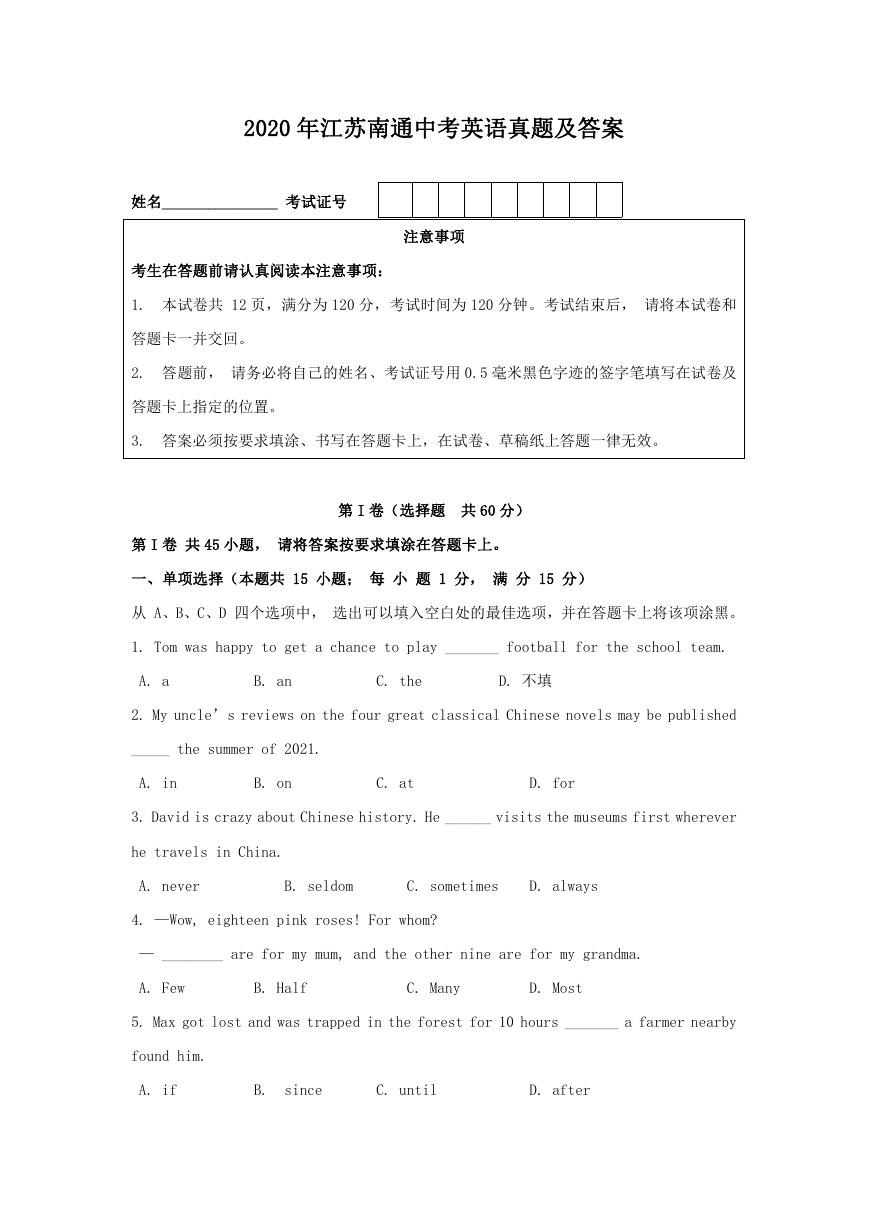
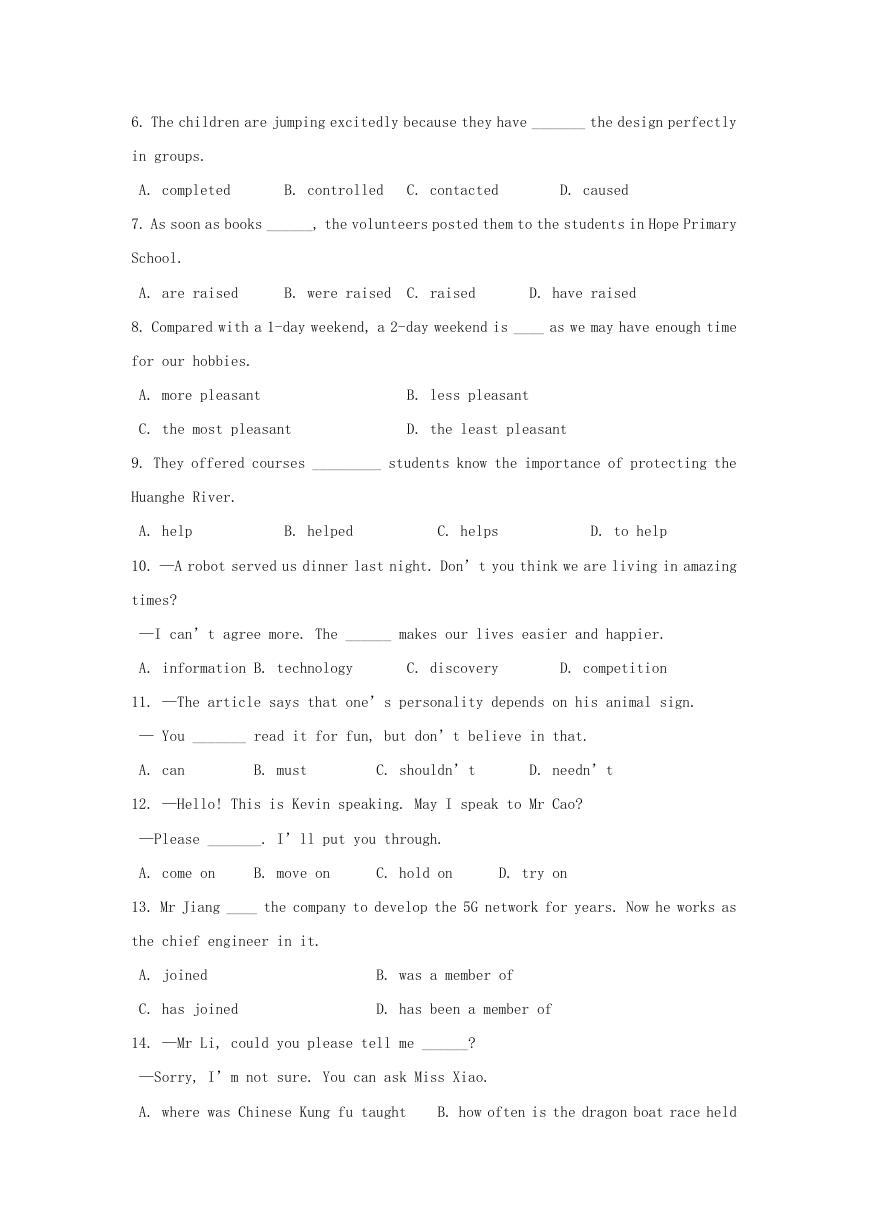
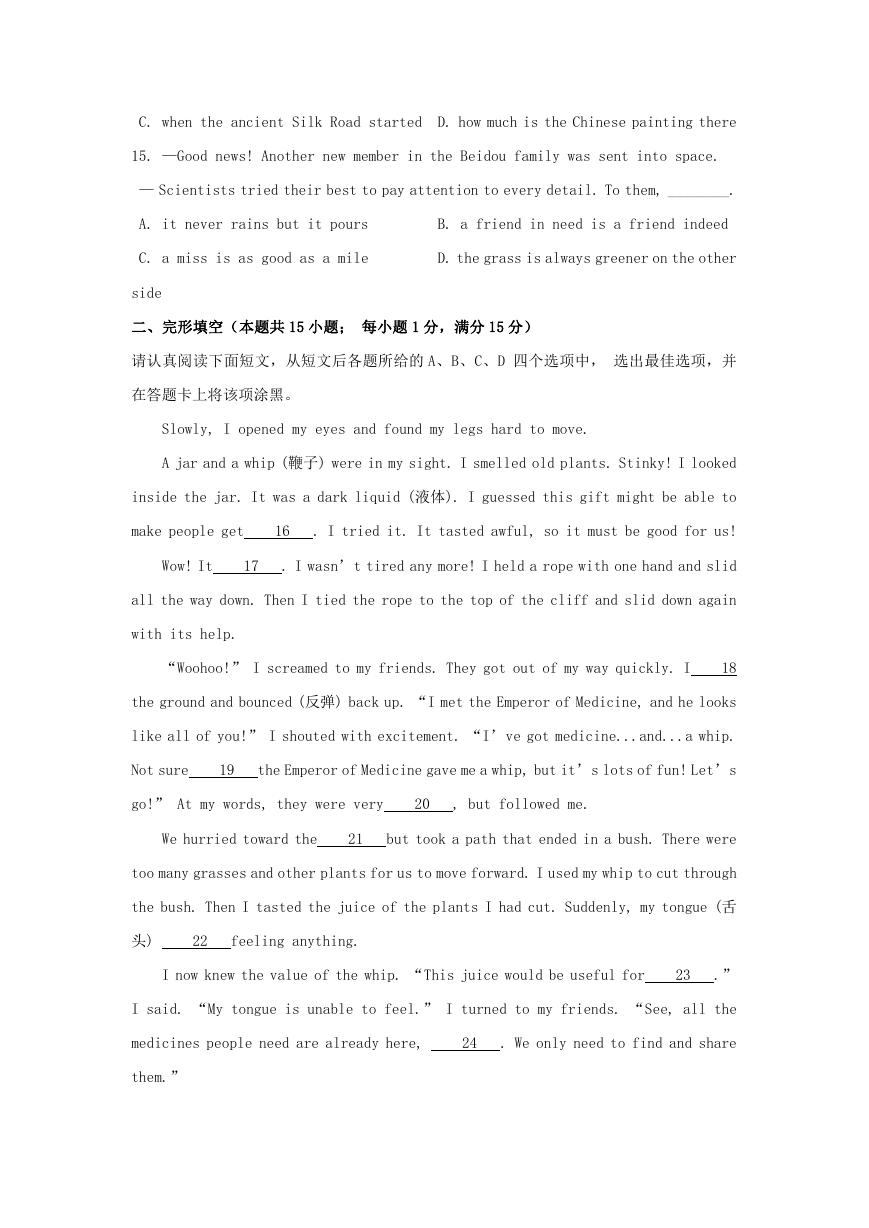
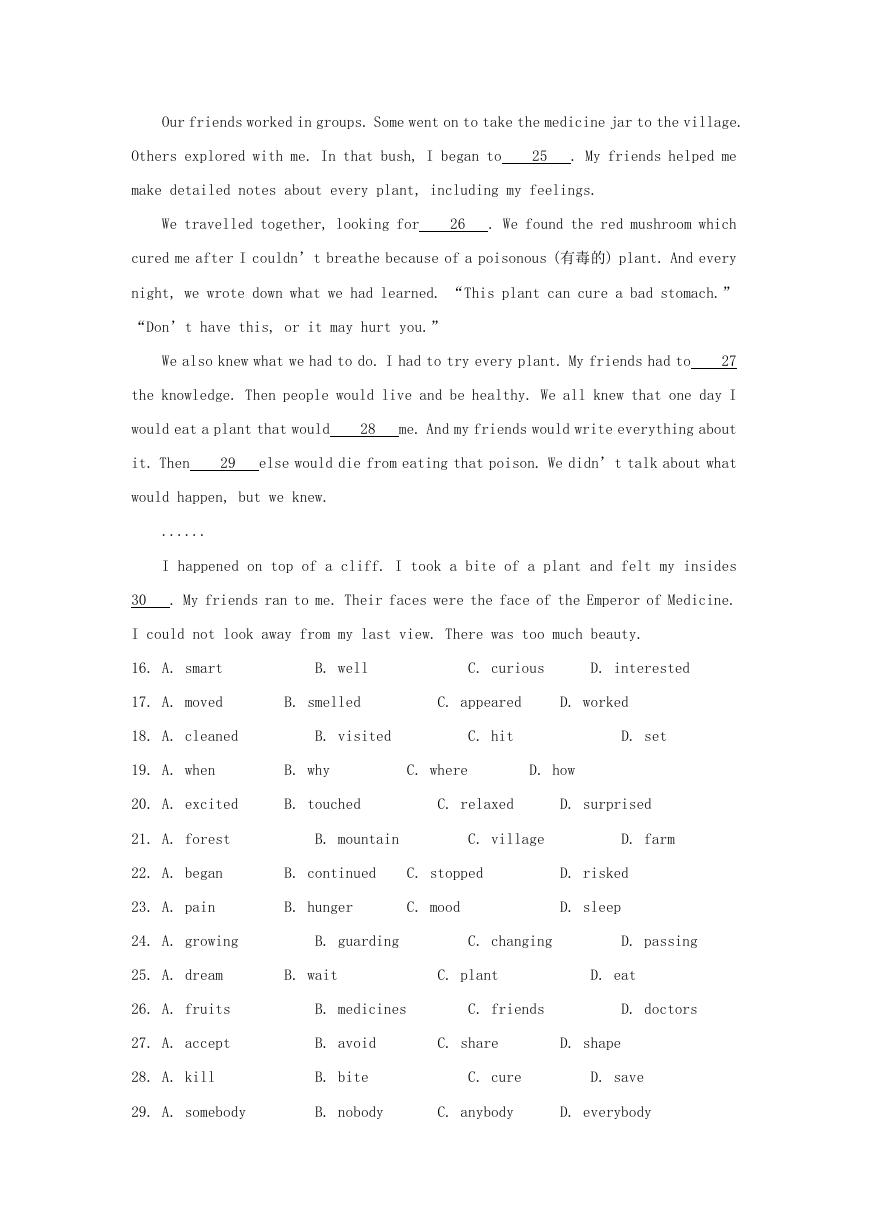
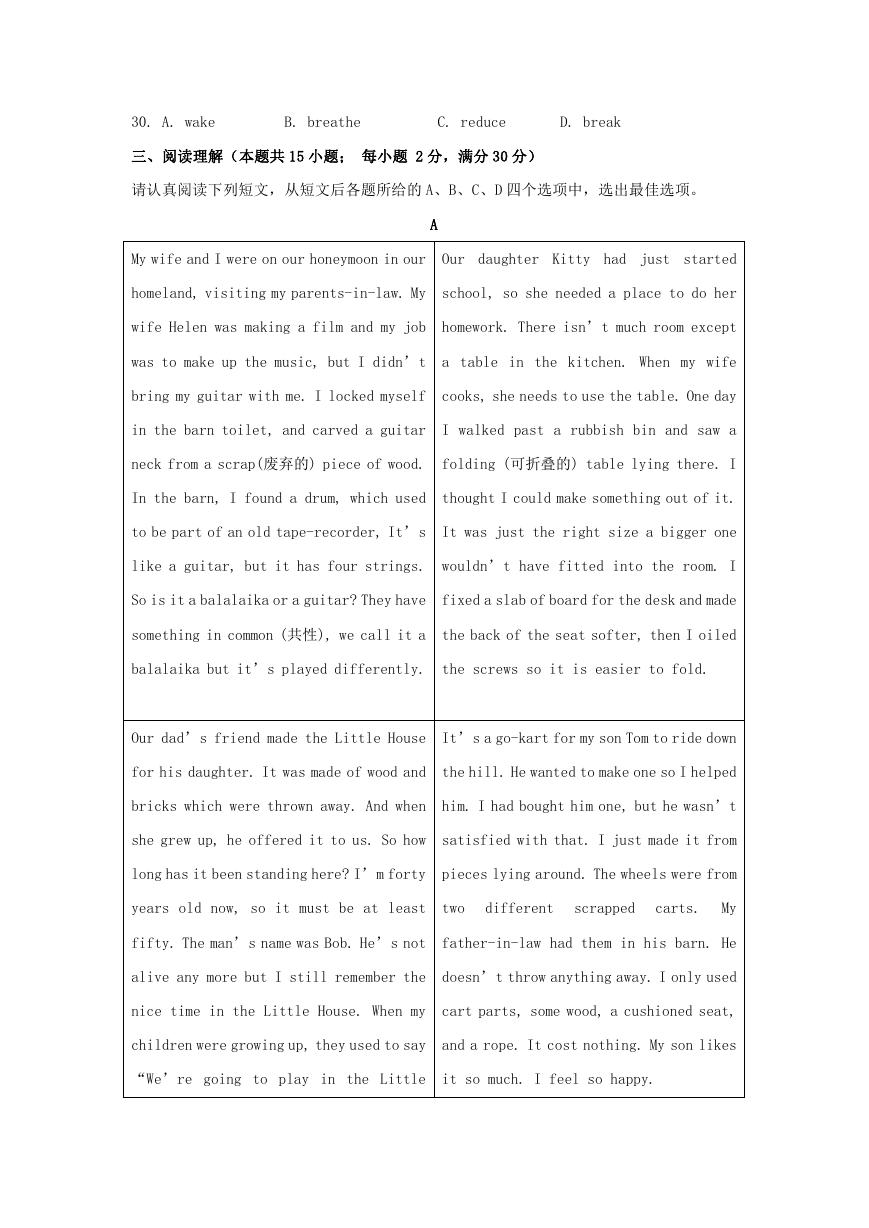

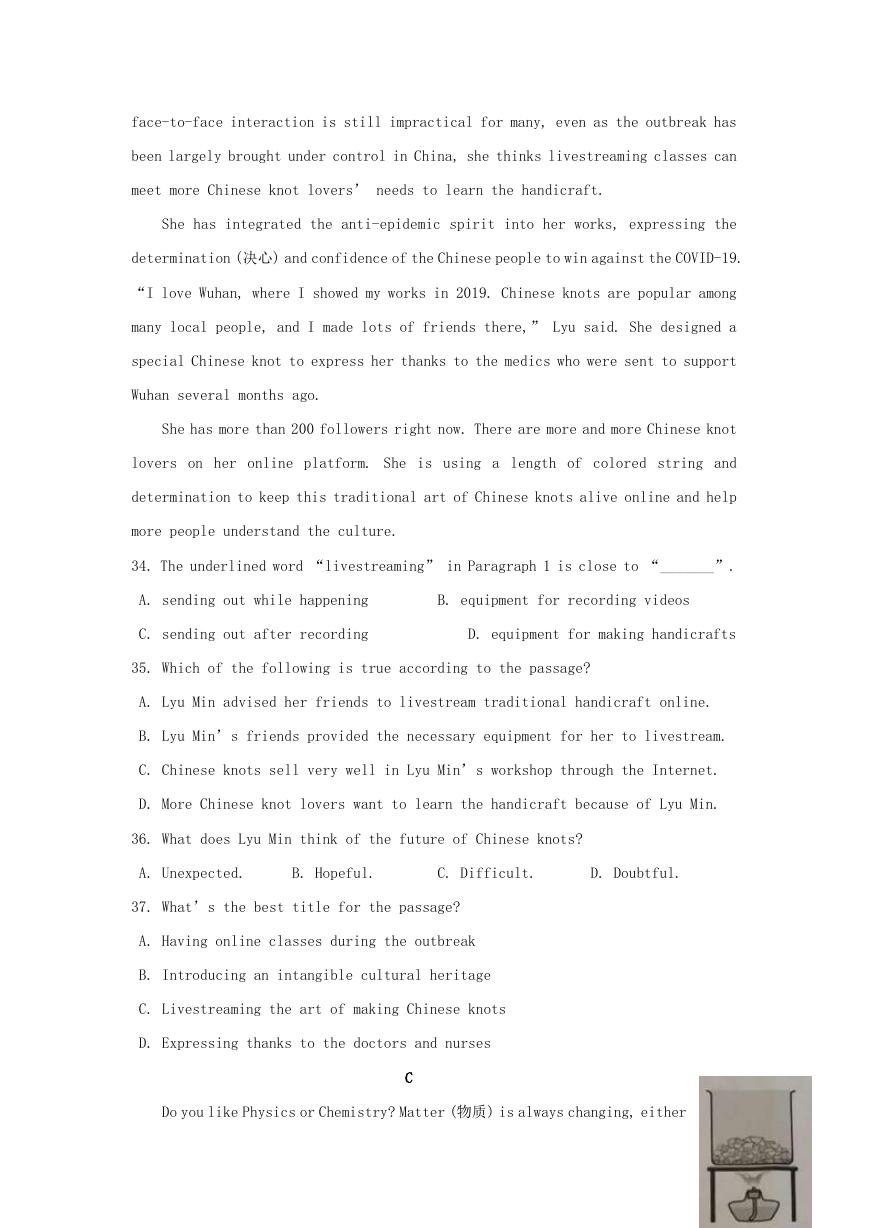
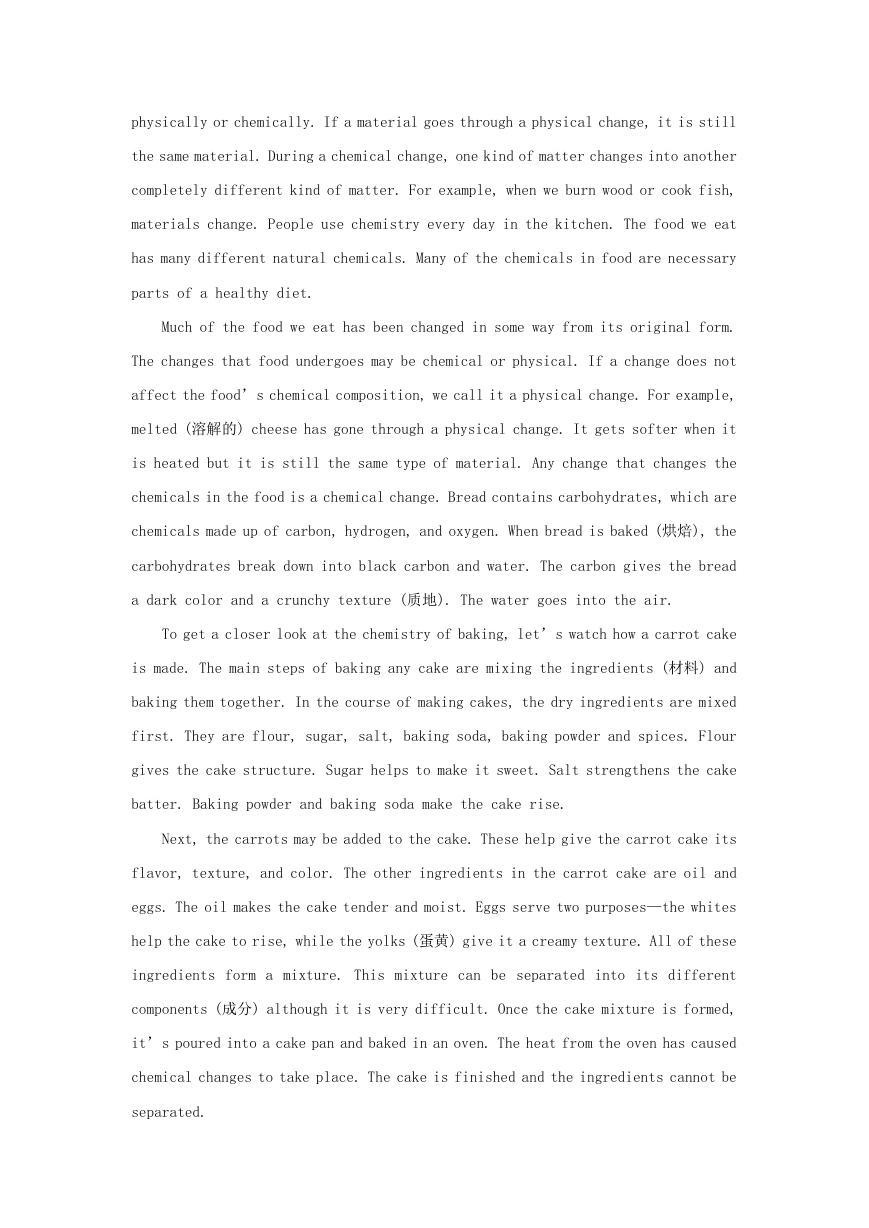








 2023年江西萍乡中考道德与法治真题及答案.doc
2023年江西萍乡中考道德与法治真题及答案.doc 2012年重庆南川中考生物真题及答案.doc
2012年重庆南川中考生物真题及答案.doc 2013年江西师范大学地理学综合及文艺理论基础考研真题.doc
2013年江西师范大学地理学综合及文艺理论基础考研真题.doc 2020年四川甘孜小升初语文真题及答案I卷.doc
2020年四川甘孜小升初语文真题及答案I卷.doc 2020年注册岩土工程师专业基础考试真题及答案.doc
2020年注册岩土工程师专业基础考试真题及答案.doc 2023-2024学年福建省厦门市九年级上学期数学月考试题及答案.doc
2023-2024学年福建省厦门市九年级上学期数学月考试题及答案.doc 2021-2022学年辽宁省沈阳市大东区九年级上学期语文期末试题及答案.doc
2021-2022学年辽宁省沈阳市大东区九年级上学期语文期末试题及答案.doc 2022-2023学年北京东城区初三第一学期物理期末试卷及答案.doc
2022-2023学年北京东城区初三第一学期物理期末试卷及答案.doc 2018上半年江西教师资格初中地理学科知识与教学能力真题及答案.doc
2018上半年江西教师资格初中地理学科知识与教学能力真题及答案.doc 2012年河北国家公务员申论考试真题及答案-省级.doc
2012年河北国家公务员申论考试真题及答案-省级.doc 2020-2021学年江苏省扬州市江都区邵樊片九年级上学期数学第一次质量检测试题及答案.doc
2020-2021学年江苏省扬州市江都区邵樊片九年级上学期数学第一次质量检测试题及答案.doc 2022下半年黑龙江教师资格证中学综合素质真题及答案.doc
2022下半年黑龙江教师资格证中学综合素质真题及答案.doc